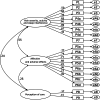Evaluate construct validity of the Revised American Pain Society Patient Outcome Questionnaire in gynecological postoperative patients using confirmatory factor analysis
- PMID: 33451283
- PMCID: PMC7809867
- DOI: 10.1186/s12871-020-01229-x
Evaluate construct validity of the Revised American Pain Society Patient Outcome Questionnaire in gynecological postoperative patients using confirmatory factor analysis
Abstract
Background: The Revised American Pain Society Patient Outcome Questionnaire (APS-POQ-R) evaluates the patient-reported quality of pain management in adults. A validated APS-POQ-R is pivotal to guide effective pain management with better patient satisfaction. Previous studies revealed that subscales of "patients' perception of pain management" were unstable cross-culturally. This study aims to evaluate the construct validity of the APS-POQ-R in gynecological postoperative patients with a multi-cultural background using confirmatory factor analysis to allow comparisons among different a priori models at the latent factor level.
Methods: Patients aged 18 years old or above and who were scheduled for gynecology surgery were selected. Three different models with a combination of latent factors were based on a priori hypotheses from previous studies. The root-mean-squared error of approximation, comparative fit index, Tucker-Lewis Index, Chi-squared test, and change in Chi-squared statistic given a change in degrees of freedom between models were used to assess the model fit to the present data.
Results: A total of 302 patients completed the questionnaire. The five-factor model which was based on Gordon's study has an acceptable fit for the data and was superior when compared to the one-factor baseline model. Although the four-factor model, which originated from Botti's study, also demonstrates a good model fit, the "perception of care" construct was excluded in this model. The "perception of care" construct is conceptually important as patient-centered care has become the focus of quality improvement of pain service.
Conclusions: The APS-POQ-R is easy to administer and is useful for quality evaluation in postoperative pain management. The present study demonstrates that a five-factor structure of the APS-POQ-R is the best fitting model in our patient sample. The results of this study provide further evidence to support the use of APS-POQ-R as a measurement tool for pain management evaluation in acute postoperative patients with a multi-cultural background.
Keywords: Construct validity; Factor analysis; Pain management; Patient management; Postoperative pain.
Conflict of interest statement
No conflict of interest from all authors.
Figures
Similar articles
-
Psychometric evaluation of the Danish version of a modified Revised American Pain Society Patient Outcome Questionnaire (APS-POQ-R-D) for patients hospitalized with acute abdominal pain.Scand J Pain. 2019 Jan 28;19(1):117-130. doi: 10.1515/sjpain-2018-0106. Scand J Pain. 2019. PMID: 30352045
-
Cross-cultural examination of the structure of the Revised American Pain Society Patient Outcome Questionnaire (APS-POQ-R).J Pain. 2015 Aug;16(8):727-40. doi: 10.1016/j.jpain.2015.03.016. Epub 2015 May 19. J Pain. 2015. PMID: 25998207
-
Evaluation of the quality of acute pain management in a pediatric surgical setting: Validation of a parent proxy modified version of the revised American Pain Society Patient Outcome Questionnaire.Paediatr Anaesth. 2019 Jan;29(1):68-76. doi: 10.1111/pan.13528. Epub 2018 Oct 31. Paediatr Anaesth. 2019. PMID: 30381868
-
[Confirmatory factor analysis of the shortened dentine hypersensitivity experience questionnaire].Hua Xi Kou Qiang Yi Xue Za Zhi. 2018 Jun 1;36(3):267-270. doi: 10.7518/hxkq.2018.03.007. Hua Xi Kou Qiang Yi Xue Za Zhi. 2018. PMID: 29984926 Free PMC article. Review. Chinese.
-
The development, assessment, and selection of questionnaires.Optom Vis Sci. 2007 Aug;84(8):663-74. doi: 10.1097/OPX.0b013e318141fe75. Optom Vis Sci. 2007. PMID: 17700331 Review.
Cited by
-
Dexamethasone versus Dexmedetomidine as Adjuvants in Ultrasound Popliteal Sciatic Nerve Block for Hallux Valgus Surgery: A Mono-Centric Retrospective Comparative Study.Drug Des Devel Ther. 2024 Apr 17;18:1231-1245. doi: 10.2147/DDDT.S442808. eCollection 2024. Drug Des Devel Ther. 2024. PMID: 38645991 Free PMC article.
-
Enhancing pain care with the American Pain Society Patient Outcome Questionnaire for use in the emergency department (APS-POQ-RED): validating a patient-reported outcome measure.BMJ Open Qual. 2024 Mar 5;13(1):e002295. doi: 10.1136/bmjoq-2023-002295. BMJ Open Qual. 2024. PMID: 38448040 Free PMC article.
-
Functional outcomes and quality of recovery after anaesthesia and surgery - Outreaching towards protracted goals.Indian J Anaesth. 2022 May;66(Suppl 3):S133-S136. doi: 10.4103/ija.ija_356_22. Epub 2022 May 17. Indian J Anaesth. 2022. PMID: 35774242 Free PMC article. No abstract available.
-
The impact of a disparity-reduction intervention on outcomes of patients with acute coronary syndrome in the emergency department: a clinical trial.Int J Equity Health. 2025 May 12;24(1):133. doi: 10.1186/s12939-025-02496-1. Int J Equity Health. 2025. PMID: 40355946 Free PMC article. Clinical Trial.
-
Factors influencing surgical anxiety and postoperative pain: a comprehensive evaluation of psychological and gynecological determinants.BMC Womens Health. 2025 Mar 7;25(1):103. doi: 10.1186/s12905-025-03623-4. BMC Womens Health. 2025. PMID: 40050846 Free PMC article.
References
-
- Bond MR, Charlton JE, Woolf CJ, editors. American Pain Society Committee on quality assurance standards: American Pain Society quality assurance standards for the relief of acute pain and cancer pain. Proceedings of the VIth world congress on pain; 1991; Seattle: IASP Press.
-
- Gordon DB, Polomano RC, Pellino TA, Turk DC, McCracken LM, Sherwood G, Paice JA, Wallace MS, Strassels SA, Farrar JT. Revised American Pain Society Patient Outcome Questionnaire (APS-POQ-R) for quality improvement of pain management in hospitalized adults: preliminary psychometric evaluation. J Pain. 2010;11(11):1172–86. doi: 10.1016/j.jpain.2010.02.012. - DOI - PubMed
Publication types
MeSH terms
Grants and funding
LinkOut - more resources
Full Text Sources
Other Literature Sources
Miscellaneous






